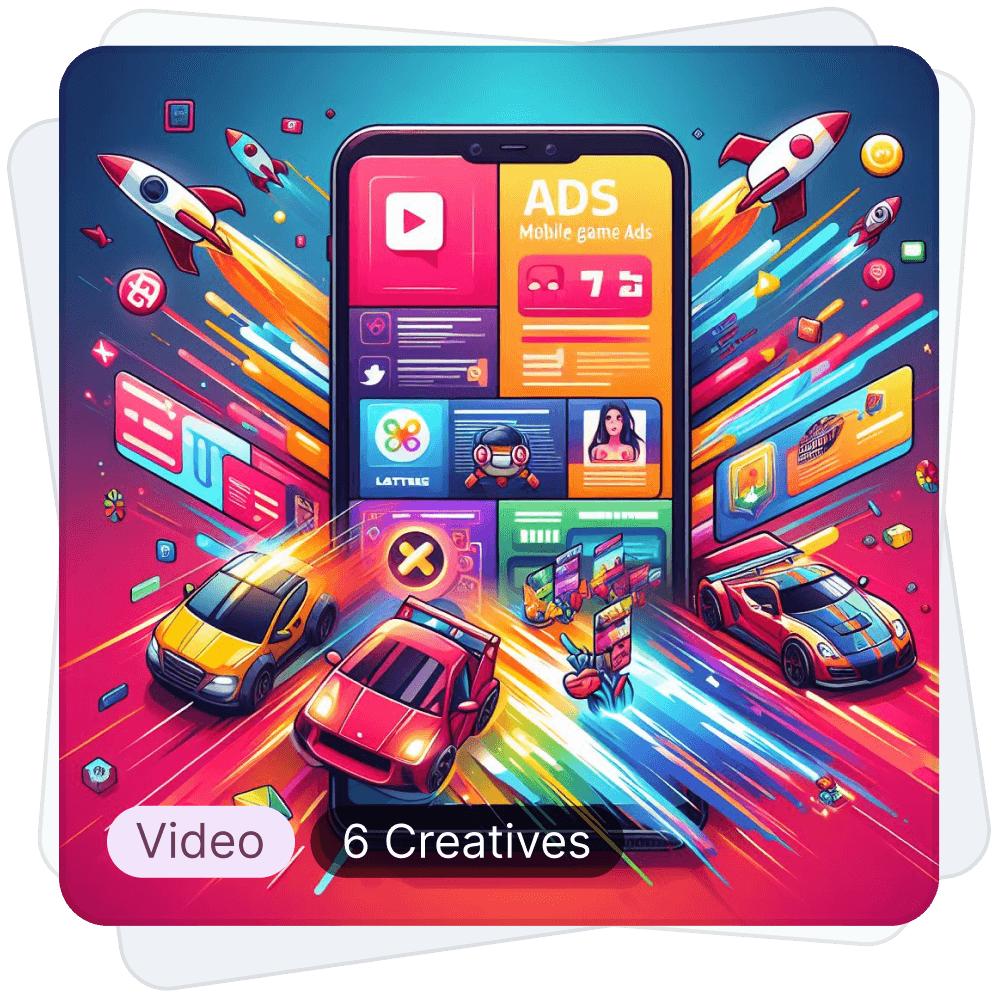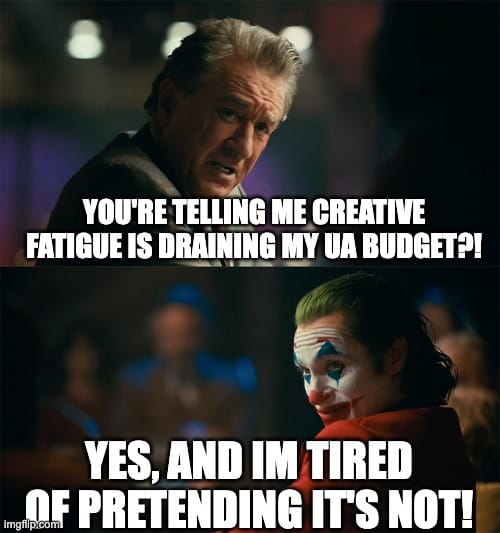How to Diagnose and Solve Creative Fatigue in Your Mobile Game Ads

Introduction
It's happened to all of us. Your mobile game ad campaign is performing amazingly well, bringing in a ton of new players at a low cost. Then, out of the blue, everything changes. Your key metrics plummet, and your once-successful ads are suddenly falling flat. Sound familiar? You're probably experiencing creative fatigue.
Creative fatigue occurs when your target audience sees your ads so often that they lose interest and stop engaging. This leads to a drop in click-through rates, skyrocketing costs, and ultimately, a significant decrease in your return on ad spend (ROAS). But don’t worry - you can combat this. This blog will teach you how to spot the warning signs of creative fatigue, implement practical strategies to overcome it, and revitalize your campaigns.
Recognizing the Signs of Creative Fatigue
The first step in tackling creative fatigue is knowing how to identify it. While a dip in ad performance isn’t always a sign of creative fatigue, certain key metrics can help you diagnose the issue:
Click-through Rate (CTR): A decreasing CTR is one of the earliest and most obvious signs of creative fatigue. It suggests your audience is becoming less interested in your ads and less likely to click on them.
Impressions: A decline in impressions can also indicate creative fatigue. This is because social media algorithms prioritise engaging content, including ads. If your audience isn’t engaging with your ads, the algorithm may show them less frequently.
Cost Per Click (CPC) and Cost Per Install (CPI): Are your costs increasing while other metrics are declining? This is another classic symptom of creative fatigue. As your ads become less effective, you’ll need to spend more to achieve the same results.
Return on Ad Spend (ROAS): Diminishing returns on your ad spend signify that your ads are losing their effectiveness. This is a clear sign that it’s time to refresh your creatives.
Ad Frequency: How many times does the average user see your ad? A high ad frequency combined with declining performance is again a strong indicator of creative fatigue. If users are constantly bombarded with the same ads, they're bound to get tired of them and tune them out.
Proxy Metrics: Additional metrics like IPM (Installs Per Mille), which measures the number of installs per thousand impressions, can provide secondary performance insights. A declining IPM, alongside other metrics, can help confirm creative burnout.
Visual Signs: On platforms like Meta/Facebook, users can provide direct feedback on ads, such as reporting them for being repetitive or leaving negative comments. Also, a drop in video completion rates for video ads can also indicate viewer fatigue.
Understanding the Difference Between Creative Fatigue and Ad Fatigue

It’s important to differentiate between creative fatigue and ad fatigue, as they require slightly different approaches.
Ad fatigue occurs when the performance of a specific ad declines because it has been shown too many times to the same audience. This can happen even if the ad itself is well-designed and engaging.
Creative fatigue, on the other hand, is a broader issue. It happens when the audience gets tired of seeing the same type of ad creative, even if the individual ads are different. This can occur when advertisers rely on a single winning concept for too long, leading to a sense of repetition and predictability.
For example, imagine you keep seeing the same ad for a mobile game repeatedly across different platforms. You might start ignoring it or actively avoiding it, leading to a decline in the ad’s performance. This is ad fatigue. However, if you start seeing multiple ads for the same game that all look and feel very similar, even if they feature different characters or gameplay footage, you might still experience fatigue and tune them out. This is creative fatigue.
Combating Creative Fatigue
The key to overcoming creative fatigue is to be proactive. Continuously test new ideas and iterate on your existing creatives to keep your ads fresh and engaging. Here are some strategies you can implement:
Creative Refresh and Variation
One of the simplest ways to combat ad fatigue is to create variations of your existing ads. This involves changing small elements while sticking to the same core concept. Don’t complicate things by changing too many elements at once. Focus on modifying one element at a time. Here are some elements you can experiment with:
Backgrounds: Changing the background colour or image can give your ad a fresh look. This is a technique employed by the popular puzzle game Brain Out. They create multiple variations of their ads with different background colours and themes, keeping their ads visually appealing even with repeated exposure.
CTA Buttons: Try experimenting with different colours, wording, and placement for your CTA buttons. Some common CTAs in mobile gaming are “Install Now”, “Download for Free”, and “Play Now”. A/B test these variations to see what resonates best with your audience.
Ad Copy: Keep your ad copy concise and engaging. Highlight the key benefits of your game and experiment with different calls to action. If a generic copy like “Best game ever” isn’t working, try something more specific to your game's content. For a puzzle game, you could try “Can you solve this?” or “98% of people can’t solve this!”.
Captions: Use captions to grab attention and convey your game's personality. Experiment with humour, trending expressions, and challenging quotes. The hyper-casual game, Wacky Run, effectively utilises captions to challenge users and encourage them to join the game.
Gameplay Footage: Showcase different aspects of your game in your video ads. This could include new levels, characters, power-ups, or even just different camera angles. The music game, Tiles Hop - EDM Rush, uses different song-gameplay combinations in its ads to create variety, making it less noticeable that the core creative is similar.
Remember: The goal is to create enough variations so that users don’t feel like they’re seeing the same ad repeatedly.
Introducing New Creative Concepts
While variations are great for short-term fixes, you’ll eventually need to introduce entirely new creative concepts to keep your audience engaged. This involves exploring different storylines, themes, or value propositions for your ads.
A/B testing is crucial when introducing new concepts. Test new concepts against your old high-performing ads to see what works best. You can keep your old concepts active until you find a new one that performs well enough to replace it. Here are some tips for coming up with fresh concepts:
Leverage Game Updates: Whenever you update your game with new features, mechanics, or levels, consider incorporating these into your ads. This is a great way to keep your ads relevant and exciting for players who are already familiar with your game, as well as attracting new players with fresh content.
Stay Current with Trends: Advertising trends are constantly evolving. What worked a year ago might not work today. Stay up-to-date with the latest trends in mobile game advertising and don’t be afraid to experiment with new visual styles, ad formats, and messaging.
Think Outside the Box: Don’t be afraid to experiment with different ad formats and approaches. Hyper-casual game, Bottle Flip 3D, uses attention-grabbing footage at the start of its videos to hook viewers and make their ads stand out.
Advanced Strategies
Dynamic Ads: Dynamic ads leverage algorithms to automatically create variations of your ads and personalise content for individual users based on their interests and behaviours. Platforms like Meta offer dynamic ad features that allow you to upload a variety of creative assets, such as videos, text options, and CTAs, which the algorithm then combines and optimises for different audience segments.
Utilise Different Ad Types: Static ads, like banner ads, can be cheaper and quicker to produce, but they are less engaging than dynamic ads, like video ads or playable ads. Consider using a combination of static and dynamic ads depending on your budget and resources.
Ad Rotation and A/B Testing: Always have multiple ads rotating at the same time. This will help reduce the chances of any single ad becoming overexposed. A/B testing different creatives is crucial to identify which ads are performing best. Allocate more of your budget to your winning ads and continue testing new concepts to find even better performers.
Frequency Capping: Frequency capping allows you to limit the number of times a single user sees your ad. This can help prevent overexposure and reduce creative fatigue, but it can also lead to unspent budgets and potentially increase CPCs.
Excluding and Retargeting Users: You can exclude users who have already engaged with your ads to prevent them from becoming fatigued. However, retargeting these users with tailored messages and creatives specifically designed for retargeting campaigns can be highly effective.
Tailoring to Audience Size: The size and diversity of your target audience will impact how quickly they experience creative fatigue. Smaller, more niche audiences will tire of seeing the same ads more quickly than larger, more diverse audiences. Adjust your creative refresh rate accordingly.
Optimising Ad Dimensions and Placements: Different ad networks and platforms have different ad size requirements. Create ads in multiple dimensions to ensure they display correctly across various platforms and reach a wider audience. This will also help you control ad frequency and prevent fatigue.
Overcoming Creative Blocks
Don’t be afraid to look at what other mobile game advertisers are doing. Tools like AppMagic allow you to browse ad creatives from specific games and categories, giving you valuable insights into current trends and successful approaches. Additionally, you can also tap into Meta Ad Library, Google Ad Library and TitTok Ad library to keep a tab on competition as well as take inspiration for new creative concepts.
Summing It Up
Creative fatigue is an inevitable challenge in user acquisition, but it's not insurmountable. By implementing the strategies outlined in this blog, you can diagnose creative fatigue and ad fatigue early, refresh your creatives effectively, and keep your ads performing at their best. Remember: produce, test, and repeat.
Don't let creative fatigue drain your budget and derail your user acquisition goals. Stay ahead of the curve and keep your audience engaged!
Lastly, you can use tools like Segwise's to help you battle creative fatigue and supercharge your ad strategy. It's powerful multi modal AI automatically tags visuals, text, audio, and other elements for all types of ad creatives across ad networks, to reveal their impact on performance metrics like CTR and return on ad spend
You can enhance your creative workflow by identify winning elements, catching creative fatigue early, and allocating budgets effectively using our data-driven insights to boost your UA returns
Compare creatives across ad networks (TikTok, Meta, Google, Applovin, etc.), countries, and campaigns to refine your creative ad strategy, uncover new opportunities, and sustain performance gains.

Comments
Your comment has been submitted successfully!